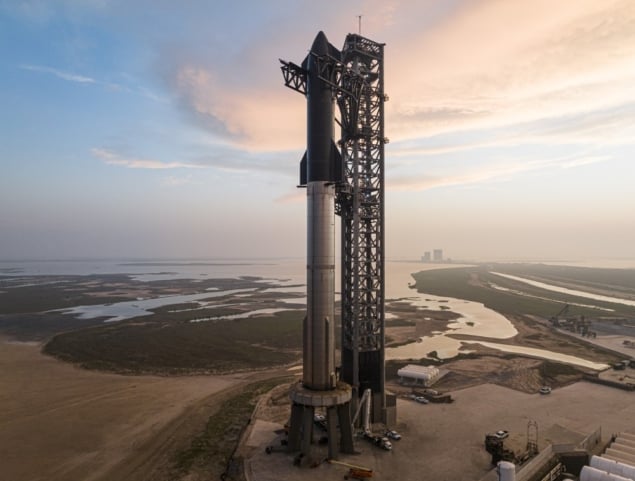
Five environmental and cultural-heritage groups are suing the US Federal Aviation Administration (FAA) following the maiden launch of SpaceX’s Starship. The launch, which took place on 20 April in Boca Chica, Texas, caused significant damage to the launchpad and the surrounding area. The groups say that by permitting take-off without a comprehensive environmental review, the FAA violated the US National Environmental Policy Act.
The maiden launch of SpaceX’s Starship atop the Super Heavy Rocket lasted for barely four minutes before it exploded. While SpaceX initially called the flight’s end “a rapid unscheduled disassembly”, it transpired that the launch team had sent a self-destruct command to the rocket as it started to lose altitude and tumble. SpaceX boss Elon Musk, however, declared the launch a success as the rocket reached an altitude of about 39 km.
Telemetry data indicated that six or seven of the rocket’s 33 engines were damaged, possibly by material torn from the pad during the launch. “[The launch] was 70% success, 30% failure,” says systems engineer Olivier de Weck from the Massachusetts Institute of Technology. “This was a very first test flight and a big success from a rocket development perspective – it reached maximum pressure and sent back a lot of telemetry.”
Any little thing that goes wrong can cause a zipper effect that creates a giant problem
Philip Metzger
Damage to the launchpad was hardly unexpected. Three months before the launch, Musk noted that SpaceX had begun work on a water-cooled steel plate that would be placed beneath the concrete pad to help it deal with the heat and force of the engines’ firing. As SpaceX thought that the pad would survive the launch, based on an earlier test, it went ahead despite the plate not being ready.
The damage, however, was far worse than expected. According to Philip Metzger from the University of Central Florida, the concrete in the pad cracked and gases from the engines splayed into them, which split the concrete further. This resulted in pieces of concrete being catapulted across the launch site together with the ejection of huge amounts of dust over several square kilometres.
“Launch and landing pads are touchy,” Metzger noted on Twitter. “Any little thing that goes wrong can cause a zipper effect that creates a giant problem.”
Other damage included the destruction of multiple cameras set up to snap the lift-off as well as a 14,000 m2 fire in a state park near the launch pad. The five groups suing the FAA say that “catastrophic damage” was caused on the ground nearby while the US Fish and Wildlife Service found debris scattered over 1.5 km2 of SpaceX property and the state park.
‘Agile development’
The organizations suing the FAA say it should have carried out an in-depth environmental impact statement before approving the launch. They argue that the agency used “a considerably less thorough analysis” than originally planned “based on SpaceX’s preference”. The analysis did not, for example, consider the possible closure of the road leading to the launch site and the public beach next to the site.
The impact of the test launch also indicates the difference in approach between SpaceX and NASA – and between governmental and commercial space programmes generally. A question of timing
“In systems engineering we talk about the waterfall process, carried out in a measured, rather slow, tedious step by step way,” de Weck told Physics World. “With SpaceX, it’s now agile development – a fast, test-driven process that is used in software coding.” In other words, SpaceX is more prepared to lose rockets and crewless spacecraft to perfect the technology as quickly as possible.
The next launch of the Starship and the Super Heavy Rocket now awaits installation of the cooled steel plate on the launchpad as well as the completion of an FAA investigation into the mishap. “Success comes from what we learn,” SpaceX states on its website. “We learned a tremendous amount about the vehicle and ground systems…that will help us improve on future flights of Starship.”



